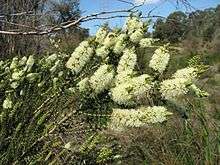Melaleuca squarrosa
Melaleuca squarrosa, commonly known as scented paperbark, is a plant in the myrtle family, Myrtaceae and is endemic to south eastern parts of Australia, especially Tasmania. It is an attractive shrub with dense foliage and arching branches and it flowers profusely in spring or early summer, bearing spikes of perfumed yellow to white flowers.
| Scented paperbark | |
|---|---|
 | |
| M. squarrosa at Langwarrin, Victoria | |
| Scientific classification | |
| Kingdom: | Plantae |
| Clade: | Tracheophytes |
| Clade: | Angiosperms |
| Clade: | Eudicots |
| Clade: | Rosids |
| Order: | Myrtales |
| Family: | Myrtaceae |
| Genus: | Melaleuca |
| Species: | M. squarrosa |
| Binomial name | |
| Melaleuca squarrosa | |
Description
Melaleuca squarrosa is a shrub, sometimes a small tree growing to 0.5–10 m (2–30 ft) high, with white or grey papery bark. Its leaves are arranged in alternating pairs (decussate) so that its leaves are in four rows along the stems. They are 5–16.2 mm (0.2–0.6 in) long, 2.5–8.2 mm (0.1–0.3 in) wide, flat and linear to narrow egg-shaped tapering to a point. They have between 5 and 7 distinct veins.[2][3][4][5]
The cream-coloured flowers are arranged in spikes at the ends of branches which continue to grow after flowering. Each spike contains 4 to 20 individual flowers and is up to 22 mm (0.9 in) in diameter and 40 mm (2 in) long. The petals are 2–2.7 mm (0.08–0.1 in) long and fall off as the flower matures. There are five bundles of stamens around the flower, each with 6 to 12 stamens. Flowering mostly occurs in spring or early summer and is followed by fruit which are woody, cup-shaped to spherical capsules, 2.7–3.5 mm (0.11–0.14 in) long.[2][3][4]

Taxonomy and naming
Melaleuca squarrosa was first formally described in 1802 by James Edward Smith in Transactions of the Linnean Society of London[1] who acknowledged James Donn as follows:
"I am indebted to the Rev. Mr. Davies, F.L.S. Vice-Master of Trinity College London, for specimens of this shrub, which was raised in the Botanic Garden of the University by Mr. Donn, from seeds brought from Port Jackson, and flowered in 1799."[6]
The specific epithet (squarrosa) is a Latin word meaning "rough with stiff bracts, leaves or scales".[7]
Distribution and habitat
Melaleuca squarrosa scrub is widespread throughout the west, north-east and far north-west of Tasmania especially in swampy areas.[8] On the mainland it occurs between areas near Sydney, south through Victoria to the far south-east of South Australia, growing in heath and dry sclerophyll forest in damp places in coastal districtsand the adjacent ranges.[2][4]
Use in horticulture
This melaleuca is a useful plant as a screen plant because of its neat, dense foliage and attractive, sweetly scented flowers.[9]
References
- "Melaleuca squarrosa". APNI. Retrieved 9 June 2015.
- Brophy, Joseph J.; Craven, Lyndley A.; Doran, John C. (2013). Melaleucas : their botany, essential oils and uses. Canberra: Australian Centre for International Agricultural Research. p. 338. ISBN 9781922137517.
- Holliday, Ivan (2004). Melaleucas : a field and garden guide (2nd ed.). Frenchs Forest, N.S.W.: Reed New Holland Publishers. pp. 266–267. ISBN 1876334983.
- "Melaleuca squarrosa". Royal Botanic Garden Sydney; PlantNet. Retrieved 9 June 2015.
- "Melaleuca squarrosa". Government of Victoria; Department of Economic Development, Jobs, Transport and Resources. Retrieved 9 June 2015.
- Smith, James Edward (1802). Transactions of the Linnean Society (Volume 6). London. pp. 300–301. Retrieved 10 June 2015.
- Brown, Roland Wilbur (1956). The Composition of Scientific Words. Washington, D.C.: Smithsonian Institution Press. p. 670.
- "Melaleuca squarrosa" (PDF). Tasmanian Government Department of Primary Industry, Parks, Wildlife and Environment. Archived from the original (PDF) on 10 June 2015. Retrieved 10 June 2015.
- Wrigley, John W.; Fagg, Murray (1983). Australian native plants : a manual for their propagation, cultivation and use in landscaping (2nd ed.). Sydney: Collins. p. 268. ISBN 0002165759.